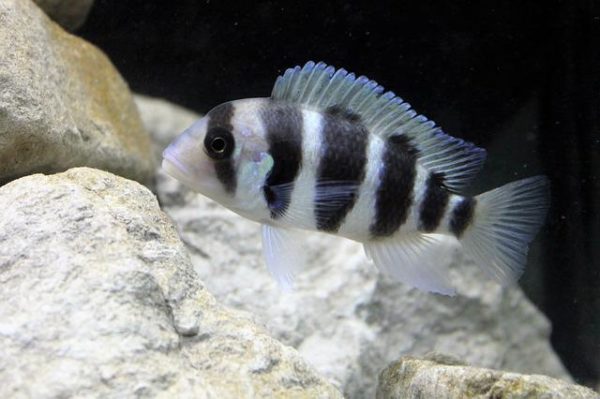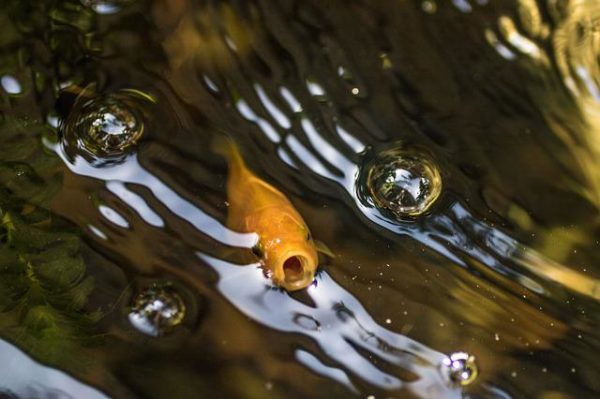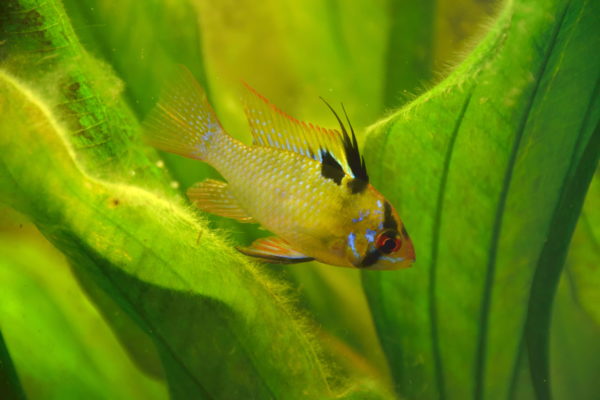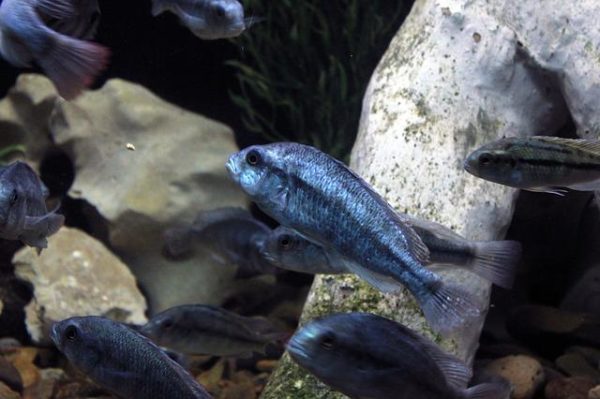Cichlids are long-living fish. If you care for them well, they can live up to 10 years. There are thousands of Cichlid varieties, but they all succumb to the same illnesses.
Even though the ideal lifespan of a Cichlid is much more, certain factors may prevent them from living longer. Let us look at how we can identify those symptoms early on and prevent Cichlids from meeting their deaths.
Also Read: Types Of Cichlids That Can Live Together
Table of Contents
How Do You Know If Your Cichlid Is Dying?

Many signs point out sickness or underlying death in a fish. However, in the case of Cichlids, like most fish, there are some ways that you can identify that your Cichlid is dying.
1. Loss of Appetite or Erratic Eating Behaviors
If your Cichlid refuses to eat, it can be a sign that your Cichlid is not doing well. There can be many reasons why your fish is not eating. One of them could be a change in their diet or a type of fish food that does not agree with them. Also, if their digestive systems are not on track, they will refuse to eat. Whatever the reason, if your Cichlid refuses to eat, it will die.
2. Spots, Dull Color, or Wounds on Cichlid’s Bodies
One reason could be the stress if you see any faded coloration on your Cichlid. Pressure decreases the brilliance of the body color of a Cichlid. Usually, the color comes back after some time, but if it does not do that after some weeks, they are dying. White spots may also appear on its scales if the fish is sick. Wounds are also a standard indicator that your fish may be dying. Wounds on a Cichlid can occur for many reasons. One of the most common reasons for a wound is a fight or a bigger fish that nips the fins of the Cichlids. Sometimes, wounds also occur if your fish crashes with some jagged decor pieces. It may injure itself.
Also Read: African Water Fern Guide
3. Difficulty in Breathing
If your Cichlid is having difficulty breathing, then that indicates a disease. If there is an underlying disease that your fish is suffering from, it may show an abnormal respiration rate. This abnormal rate can manifest as your fish breathing hard and fast or not being able to breathe.
Also Read: CO2 Setup – Basic Guide
4. Gasping

It is terrible if you find your Cichlid gasping for air or floating very close to the tank’s surface. Trying to breathe in the oxygen from the top shows something wrong with the fish—either that or the water conditions. For example, the ammonia levels in the water might be high, leading to a lack of oxygen inside the tank. It would help if you addressed this, or it will lead to your fish not breathing enough and, as a result of it, dying.
5. Cichlid Lying Motionless At The Bottom of The Tank
This is a bit of a gray area to navigate. Most fish, including Cichlids, are bottom-dwellers. Sometimes, you will find your fish lying down at the bottom of the tank without moving. This could mean anything out of the three. First, your fish is tired and resting; second, your fish is ill and cannot move; third: your fish is dead. To find out if this is a sign to worry, monitoring the behavior of your Cichlids is essential. If your fish usually swims in the top part of the tank but is now at the bottom, it may be because of some illness. On the other hand, if your Cichlid is very active but seems to be hardly moving or acting lethargic, you should know that something is wrong.
6. Strange Sleeping Habits
All fish have strange sleeping positions. Sometimes, if your fish is at the bottom of the tank, hiding inside a decor piece or in the corner of the tank without moving, it might be sleeping. Cichlids do not have lids like all the other fish, so you might not even know whether they are sleeping. One sure way to check that your Cichlid is dying is that they exhibit this behavior for a prolonged period.
7. Cichlid Floating Sideways or Losing Weight
Both of these actions say that the Cichlid is reaching old age. The more the fish age, the more they start behaving strangely. If your Cichlid needs more rest or starts floating sideways, then this is a sign that they’re dying. Similarly, they tend to eat less and less because of old age, and their appetite decreases. This leads to weight loss and makes your fish weak. This weight loss can even alter your fish’s appearance and shape. Sometimes your Cichlid may appear elongated.
Cichlid Fish’s Reason for Death

Diseases and parasitic infections
Cichlids are often infected by fungal and bacterial infections, which affect their breathing. Some symptoms of parasitic infections are lack of energy, fatigue, slow movement, and heavy breathing.
Diseases such as Ich, Swim Bladder Disease, Tuberculosis, Malawi Bloat, and Cotton Wool Disease are some of the major diseases that kill Cichlids.
Fighting and harrassment
Cichlids are usually peaceful and do well in a community. However, if your Cichlid is picking fights with other Cichlids or harassing them by nipping their fins, then there is a high chance that your fish will succumb to wounds and nips.
Defective Specimens
If you buy your Cichlid from the store and it looks tired, swollen, or uninterested, your Cichlid is sick and on its way to its death bed. On the other hand, cichlids are pretty active, playful, and alert. So if your Cichlid does not behave like this, this could be one reason for its death.
Rapid Water Changes
If your water undergoes many changes suddenly, this will cause stress and discomfort to your fish. Therefore, ensuring that you keep the water conditions stable in the tank is essential, or it will lead to your Cichlid’s death.
Maladjustment to a new tank
Sometimes Cichlids go through something called ‘New Tank Syndrome. If you are using a new tank, you have to cycle it properly before introducing your Cichlids into it. If you do not cycle your tank, it will contain dangerous bacteria and less good bacteria. Your Cichlids might not be able to handle this change and die.
How Do You Save a Dying Cichlid?
There are several steps to use if you want to save your dying Cichlid.
- Separate the sick Cichlid immediately from the rest of the tank.
Even though fish owners might not think of this immediately, a sick Cichlid is a threat to other tank mates. If you do not remove your sick Cichlid immediately, the others might catch whatever disease the Cichlid is infected with.
As soon as you notice one of the signs mentioned above, you must take this precautionary measure. While separating the fish, here are some things you need to take care of:
– Cycle a new tank and ensure that the temperature of the new tank is the same as the old one.
– Do not immediately put the fish in the new tank but use the floating bag technique or drip acclimatization.
– Remember that if there are sudden changes in the fish’s environment, it can go into shock and worsen its condition. - Set the correct water parameters
After moving your Cichlid to the new tank, do a thorough check of the tank’s water parameters. Incorrect water parameters are one of the main ways to worsen your Cichlid’s health. Do not rely on traditional water testing methods but use accurate water testings kits to check the parameters. Ensure that the tank’s temperature is between 75- 82 degrees f, the pH is between 7.5-8.5, with the ammonia and nitrite levels as zero. If your ammonia, nitrite, or nitrate levels are more than zero, your ammonia and nitrite have ammonia poisoning. To counter the effect of the poisoning, you need to administer shots immediately. After checking your water parameters, ensure that you let the tank air, check the filter and the heater and clean the substrate from time to time. In case of poisoning, seek immediate help from a professional vet.
- Track the Cichlid’s behavior
Once the fish is in the new tank, you need to check it for at least a week. But, first, to understand what’s wrong with it. Sometimes specific health problems in Cichlids will show themselves in the form of gasps, spots across the body, faded color, red gills, bloating, bulging eyes, nipped fins, strange swimming patterns, and cottony substance on their skin. If any of this happens, you need to take preventative measures immediately.
How Do You Heal Injured Cichlids?
Cichlids can injure themselves for several reasons, such as getting into fights with other Cichlids, tearing their fins on their decorations, and gashing from the substrate.
To heal an injured Cichlid, pick up the fish, examine its injuries, and fill a bucket with the tank’s water. To clean the wound, stroke it with your finger; if the fish is bleeding, you must administer over-the-counter creams and feed it medication. Consult a vet before you give your fish any medicine. If there is any dirt on the fish, there is a chance that it may infect the wound. To ensure no infection, you can give your fish at-home treatment with saltwater. To do this, put your fish in a separate bucket with saltwater. To make the water salty, you can use aquarium salt. This salt will remove the toxins from the fish’s body and reduce the chance of infection.
How to Save a Cichlid Fish That is Upside Down?

If your Cichlid is swimming upside down, it probably has a defective swim bladder. This disease is called Swim Bladder Disease, which causes fish to swim erratically. If your Cichlid has Swim Bladder Disease, it will float on top of the aquarium, turned upside down. This is because they cannot maintain their balance. Something you can do to treat this disease is giving medicine to your ill fish and correct the water parameters. You can also treat your fish for constipation. If, after some days, you do not see an improvement in the belly of a fish, then you need to consult a vet.
When Should I Book An Appointment With The Vet?
The best time to book an appointment with the vet is as soon as your treatment on the fish does not yield a result. Most of the time, your treatment might worsen your fish’s conditions if not treated well. Even administering over-the-counter medication to your fish requires a prescription. Therefore, your best chance to save your dying Cichlid is to consult a vet as soon as possible.
Also Read: Is My Snail Dead or Sleeping
Conclusion
As a fish parent, it can be stressful and sad when your fish dies; it is even lower if the death is not a result of old age. Considering other fish, Cichlids live quite a long life of 10 years, but they rarely live up to their entire lifetime.
Diseases such as Swim Bladder Disease, bacterial infections, etc., can prove fatal to your fish. Even small things like lack of air, tiny wounds, and fatigue can endanger your fish’s health. To save a dying Cichlid, you should perform regular water changes, give them the proper diet, monitor their symptoms, and not skip the vet’s visit. Correct diagnosis and timely treatment will make your Cichlid live.
No related posts.
